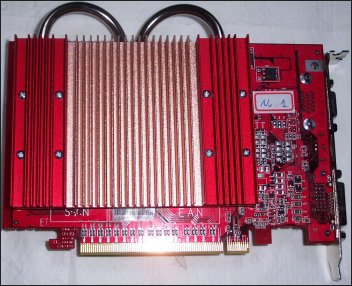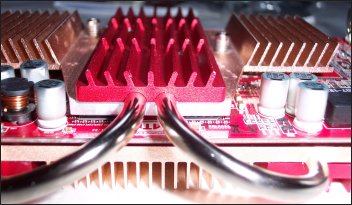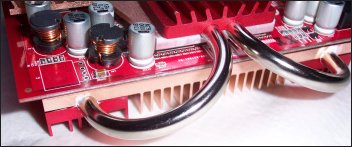GeCube SilenCool X700 PRO 256MB
As you can see, the card is dominated by a cooler that attaches to both sides of the PCB, connected at the top edge of the board by a pair of heatpipes. It's an eight piece cooler. That's including the heatpipes and a protective plate on the rear of the PCB, to protect the board from any wayward movement that might cause the sink to clatter into the PCB, possibly damaging it. Screws do the attaching of the heatsink to the PCB, the addition of which to that basic X700 PCB design results in a card that weighs 530g, which is by far the heaviest graphics product I've submitted to my digital scales.
The photographs above show how the heatpipes connect to the sinks, enclosed on two sides by a heatsink and interfacing with both using a thermal interface material, smatterings of which you can see around the point where they all meet.
Having a PEG16X physical interface to the PCI Express host, and being powered by ATI's frugal RV410, the GPU needs no extra power source. Connectivity options are video out (more on which shortly), analogue VGA and digital DVI, for dual monitor support.
In terms of size, the heatsinks on the rear of the board (the no-GPU side) are what you have to worry about the most. Depending on the proximity of various components to your mainboard's PEG16X slot, you might have trouble fitting the SilenCool X700 PRO. For example, on an ASUS A8N-SLI nForce4 mainboard that I have in for evaluation, the heatsinks on the rear will foul the Molex connector you plug in near the top PEG16X slot, to provide extra power to the PEG16X slot pairing. It fits, but there's some wiggling of the Molex to be done, after you've inserted and retained the SilenCool. While it's not a problem in reality - why would you pair the SilenCool with an SLI mainboard - the distance between components on your target mainboard and the PEG16X slot for the SilenCool needs considering.
Talking about the heatsink design, the direction of the fins is at odds with general airflow direction in your usual ATX chassis, however I'm assured that the size and angle of the fins isn't enough for that to make any great difference to cooling performance. The design of the sinks is such that the memory modules on the board, of which there are eight 32MB Samsung GDDR3 GC16 DRAMs for a total of 256MB, aren't cooled at all by the sinks. The only part of the entire heatsink assembly that touches the board or any components is the interface with the GPU, the rest of the sinks held above the PCB's surface.
GeCube advise me that shipping X700 PRO 256MB SilenCools to retail will contain GC20 DRAM devices, rather than the GC16s you see here which usually found on an XT Platinum Edition of some description.
The heatpipe interface on the GPU side of the board is directly above the GPU itself, GeCube designing the heatsink so that the heatpipes remove the heat from the GPU side and move it to the uppermost side with the larger copper mass, for radiation into your case, your chassis airflow then removing it.
That means the winged sections of the heatsink assembly on the GPU side are somewhat for show, since they don't interface with anything on the board and the heatpipe design moves heat to the uppermost sink as much as possible. That's not to say they have no cooling ability; if you touch the winged sections after a couple of hours of load, you'll feel the heat in them, showing the heatsink is working properly.
To sum up, it's a large, heavy passive cooling solution for a hot GPU. I'll examine how effective it is shortly.













